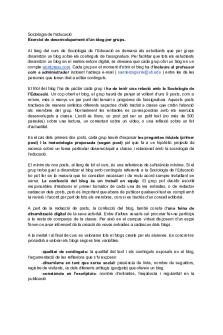Blog work - final eatwell guide PDF

| Title | Blog work - final eatwell guide |
|---|---|
| Course | Nutrition 21 |
| Institution | Manchester Metropolitan University |
| Pages | 5 |
| File Size | 260.5 KB |
| File Type | |
| Total Downloads | 91 |
| Total Views | 147 |
Summary
Coursework submission for Nutrition 21 - creating a blog piece....
Description
16002521 Nutritional Sciences: Level 4 Blog- What are the drawbacks and benefits of the Eatwell Guide The Eatwell Guide was created in 2016 by Public Health England to promote healthier eating within the population. It provides a simple understanding of a nutritionally balanced diet, which offers health benefits: increased life expectancy, reduced risk of illness and medical conditions including diabetes and heart disease (Wilson, 2016).
The guide includes a circular image, split into sections featuring colourful drawings of foods; representing the five main food groups: fruit and vegetables, meats and fish or alternatives, dairy, fats, and carbohydrates. Bright colours are a visual aid making it less serious and less medical. This guide assumes no prior knowledge: beneficial to those less engaged with food; the target group (Public Health England, 2016; Buttriss, 2016). Displaying a variety of foods intended to make nutritional eating sustainable and achievable. Click ‘pie chart‘ for results from the author’s questionnaire: How easy would you find it to make a nutritionally balanced main meal based on the food ingredients shown in the guide?
Very easy Relatively easy Not easy at all
Further guidance on dietary health is placed around the circular image. Information on hydration recommends six to eight glasses of water a day: used by cells and organs in aiding digestion. However, the guide does not distinguish between pure water and other sources including caffeine, which can cause headaches and insomnia (Moreau, no date). A nutritional label, using the traffic light system, found on food packaging is shown: enabling everyone to determine the nutritional composition of foods (Loureiro, 2012).
16002521 Nutritional Sciences: Level 4
‘Junk foods’ are excluded from the circular shape: foods high in fat, salt and sugar are advised to be eaten less frequently and in smaller amounts (Public Health England, 2016). Information in the guide is supported by other public health messages such as the 5-a-day and Change4Life campaigns; making it a reliable source. The nation’s health is the main consideration for this guide, but does it regard requirements of all population groups? Each section provides suitable options for the 3.25% of the population identified as vegetarian or vegan (The Vegan Society, 2016). This group has tripled in size within ten years and will be an important consideration when the guide is reviewed. The guide is less helpful in recognising the needs of diverse cultures. Certain foods may not be their primary source (Buttriss, et. al., 2017). In 2015, 8.6 million people within the UK were immigrants (Ons.gov.uk, 2016): providing information on religious dietary laws would allow this guide to impact more of the population.
Despite showing the proportions involved in a balanced diet, portion sizes are not accurately represented, making the recommendations hard to achieve (Clark, 2016). Five pieces of fruit or vegetables a day, but two portions of fish a week; without standardising measurements, the guide can be confusing. Precise requirements need research, making this guide less accessible. The guide recommends basing meals on carbohydrates, but although advising wholegrain or high fibre, this information is conflicting for people trying to lose weight; as one third of the recommended food intake is starchy foods: potatoes, rice and pasta (Czyżewska-Majchrzak, 2014). High carbohydrate intake raises blood glucose: harmful for diabetics (Diabetes UK, 2017).
16002521 Nutritional Sciences: Level 4
Food allergies, intolerances and medical conditions require bespoke diets, rather than this generic model; but seeking medical advice is not suggested. Different cooking processes produce foods with different nutritional values (Spritzler, 2016; Ni et al., 2016), and the calorie intake displayed can only be used as a guideline as age, fitness and wellbeing affect these values; this is not stated. The Eatwell Guide is an important education tool, promoting foods in a balanced diet and their impact to health. However, it is not suitable for every population group, and the guide should mention requiring further information.
Word count (excluding citations) 545
16002521 Nutritional Sciences: Level 4 References Buttriss, J. (2016) ‘The Eatwell Guide refreshed’ Nutrition Bulletin. Volume 43 (Issue 2) pages 135-141 Buttriss, J, et. al. (2017) Public Health Nutrition. 2nd edition., The Nutrition Society, p82-84 Clark, J. (2016) ‘Encouraging patients to eat well: The new Eatwell Guide’ Practise Nursing’. Volume 7 (Issue 27). Pages 346-349 Czyżewska-Majchrzak, L, et al. (2014) ‘The use of low-carbohydrate diet in type 2 diabetes – benefits and risks’ Annals of Agricultural and Environmental Medicine. Volume 21 (Issue 2) pages 320-326 Diabetes UK. (2017). Carbohydrates and diabetes: What you need to know. [online] [Accessed 1 October 2017] https://www.diabetes.org.uk/guide-to-diabetes/enjoyfood/carbohydrates-and-diabetes Loureiro, M. (2012) ‘The effects of nutritional labels on obesity’ Agricultural Economics. Volume 46 (Issue 3) pages 333-342 Moreau, E. Caffeine overdose symptoms: The unpleasant signs and how to take the edge off. Organic Authority [online] [Accessed 1 October 2017] http://www.organicauthority.com/health/too-muchcoffee-antidote-how-to-get-the-caffeine-out-of-your-body.html. Ni, 2016, et al. (2016) ‘Consumers’ ability to match foods to the eatwell plate’ Proceedings of the Nutrition Society. Volume 75 (Issue OCE3) Ons.gov.uk. (2016). Population of the UK by Country of Birth and Nationality: 2015 - Office for National Statistics. [online] [Accessed 6 Oct. 2017] https://www.ons.gov.uk/peoplepopulationandcommunity/populationandmigration/internationalmig ration/bulletins/ukpopulationbycountryofbirthandnationality/august2016 Public Health England. (2016) The Eatwell Guide: How does it differ to the eatwell plate and why? [online] [Accessed 1 October 2017] https://www.gov.uk/government/uploads/system/uploads/attachment_data/file/528201/Eatwell_gu ide_whats_changed_and_why.pdf Spritzler, F. (2016). How Cooking Affects the Nutrient Content of Foods. Healthline [online] [Accessed 20 October 2017] https://www.healthline.com/nutrition/cooking-nutrient-content#section11 The Vegan Society. (2016). Find out how many vegans are in Great Britain. [online] [Accessed 6 October 2017] https://www.vegansociety.com/whats-new/news/find-out-how-many-vegans-aregreat-britain Wilson, D. (2017). The Benefits of Healthy Habits. Healthline. [online] [Accessed 20 October 2017] https://www.healthline.com/health/5-benefits-healthy-habits#overview1
Bibliography Clark, J. (2016) ‘Encouraging patients to eat well: The new Eatwell Guide’, Volume 27 (issue 7), p346349
16002521 Nutritional Sciences: Level 4 Koshercertification.org.uk. What is Kosher Food, Kosher Rules, Products, Definition, What Does Kosher Mean. [online] [Accessed 6 October 2017] http://www.koshercertification.org.uk/whatdoe.html Krieger, E. (2016). Is coffee hydrating? (and the truth behind other hydration myths) – The Denver Post. [online] [Accessed 6 October 2017] http://www.denverpost.com/2016/08 /29/is-coffee-hydrating-other-hydration-myths/ Ons.gov.uk. (2012). Religion in England and Wales 2011 - Office for National Statistics. [online] [Accessed 6 October 2017] https://www.ons.gov.uk/peoplepopulationandcommunity/culturalidentity/religion/articles/religionin englandandwales2011/2012-12-11 Ridgwell, J. (2016). The Eatwell Guide. [Blog] [Accessed 30 September 2017] The Nutrition Program Blog. Available at: https://blog.nutritionprogram.co.uk/2016/03/18/the-eatwell-guide/ The Vegan Society. (2017). Key facts. [online] [Accessed 6 October 2017] https://www.vegansociety.com/about-us/further-information/key-facts Williamson, D. (2011) Livewell: Healthy people, healthy planet. WWF [online] [Accessed 20 October 2017] http://assets.wwf.org.uk/downloads/livewell___healthy_people_healthy_planet.pdf...
Similar Free PDFs

Blog work - final eatwell guide
- 5 Pages

BLOG 1 - BLOG
- 3 Pages

Evidence Blog Pet peeves blog
- 1 Pages

Student-guide - Course work
- 5 Pages

12min Blog
- 4 Pages

Exercici blog
- 2 Pages

Week5 - blog
- 6 Pages

Discussion Blog
- 1 Pages

Learning Guide Unit 6 - Work
- 18 Pages

Final Lab Report - lab work
- 5 Pages

Study Guide - Final Exam Guide
- 21 Pages

Final Exam Study Guide- final
- 3 Pages

Spanish blog - Grade: A
- 1 Pages

Blog actividad 3 sena
- 2 Pages

Kopi Time - Marketing BLOG
- 7 Pages
Popular Institutions
- Tinajero National High School - Annex
- Politeknik Caltex Riau
- Yokohama City University
- SGT University
- University of Al-Qadisiyah
- Divine Word College of Vigan
- Techniek College Rotterdam
- Universidade de Santiago
- Universiti Teknologi MARA Cawangan Johor Kampus Pasir Gudang
- Poltekkes Kemenkes Yogyakarta
- Baguio City National High School
- Colegio san marcos
- preparatoria uno
- Centro de Bachillerato Tecnológico Industrial y de Servicios No. 107
- Dalian Maritime University
- Quang Trung Secondary School
- Colegio Tecnológico en Informática
- Corporación Regional de Educación Superior
- Grupo CEDVA
- Dar Al Uloom University
- Centro de Estudios Preuniversitarios de la Universidad Nacional de Ingeniería
- 上智大学
- Aakash International School, Nuna Majara
- San Felipe Neri Catholic School
- Kang Chiao International School - New Taipei City
- Misamis Occidental National High School
- Institución Educativa Escuela Normal Juan Ladrilleros
- Kolehiyo ng Pantukan
- Batanes State College
- Instituto Continental
- Sekolah Menengah Kejuruan Kesehatan Kaltara (Tarakan)
- Colegio de La Inmaculada Concepcion - Cebu
